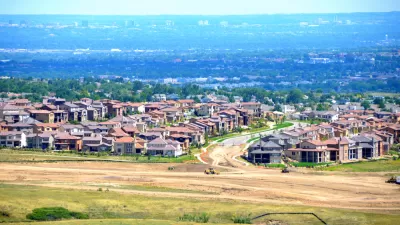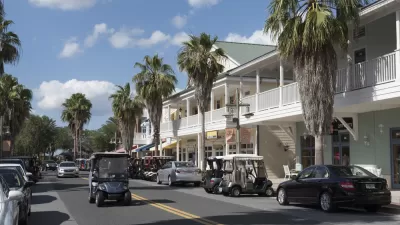Much of the focus on the potential of self-driving cars to effect change in the built environment has focused on dense, urban environments. But what is self-driving cars mostly enable continued outward expansion?

An article by Christopher Mims imagines the "weirdest thing" about a future of self-driving cars: where people will live.
Nearly everyone who has studied the subject believes these self-driving fleets will be significantly cheaper than owning a car, which sits idle roughly 95% of the time. With the savings, you will be able to escape your cramped apartment in the city for a bigger spread farther away, offering more peace and quiet, and better schools for the children.
Commuting from a "new class of exurbs" will be a luxurious affair, according to Mims, with none of the current hassles of the average commuter, particularly congestion. Mims calls on Robert McDonald, lead scientist for the Global Cities Program at the Nature Conservancy, to make the point that humans have proven themselves to spread out into sprawl as soon as their transportation modes begin to move faster.
Mims admits that he could be wrong, but not because Millennials prefer cities (an idea he debunks), but because self-driving cars could also "make cities livable in way they aren't now."
The article might be behind a paywall.
FULL STORY: Driverless Cars to Fuel Suburban Sprawl

Depopulation Patterns Get Weird
A recent ranking of “declining” cities heavily features some of the most expensive cities in the country — including New York City and a half-dozen in the San Francisco Bay Area.

California Exodus: Population Drops Below 39 Million
Never mind the 40 million that demographers predicted the Golden State would reach by 2018. The state's population dipped below 39 million to 38.965 million last July, according to Census data released in March, the lowest since 2015.

Chicago to Turn High-Rise Offices into Housing
Four commercial buildings in the Chicago Loop have been approved for redevelopment into housing in a bid to revitalize the city’s downtown post-pandemic.

New Park Opens in the Santa Clarita Valley
The City of Santa Clarita just celebrated the grand opening of its 38th park, the 10.5-acre Skyline Ranch Park.

U.S. Supreme Court: California's Impact Fees May Violate Takings Clause
A California property owner took El Dorado County to state court after paying a traffic impact fee he felt was exorbitant. He lost in trial court, appellate court, and the California Supreme Court denied review. Then the U.S. Supreme Court acted.

How Urban Form Impacts Housing Affordability
The way we design cities affects housing costs differently than you might think.
City of Costa Mesa
Licking County
Barrett Planning Group LLC
HUD's Office of Policy Development and Research
Mpact Transit + Community
HUD's Office of Policy Development and Research
City of Universal City TX
ULI Northwest Arkansas
Town of Zionsville
Urban Design for Planners 1: Software Tools
This six-course series explores essential urban design concepts using open source software and equips planners with the tools they need to participate fully in the urban design process.
Planning for Universal Design
Learn the tools for implementing Universal Design in planning regulations.






















